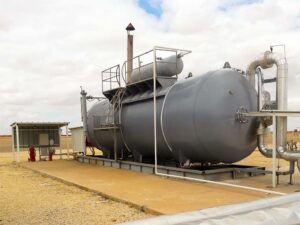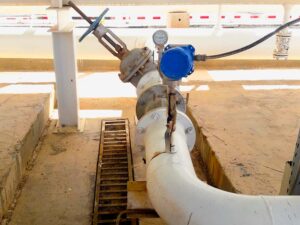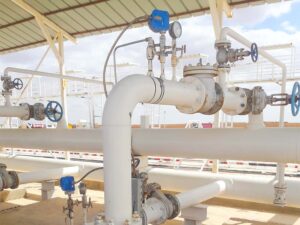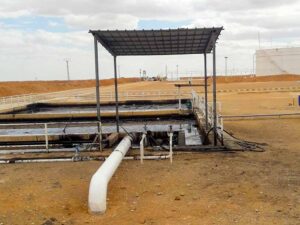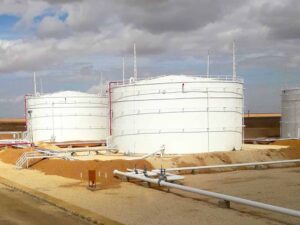BS’s Plant Development Project
The Project Overview:
The scope of the project was to design and develop new equipment for the crude oil treatment plant BS located in the SFEYEH field. The primary objective was to enhance the plant’s production capacity to produce processed oil that meets the specifications required by refineries in Syria.

Key Aspects of the Project:
- Design of New Equipment:
– The project involved creating advanced equipment tailored for the crude oil treatment process. This included desalter, heaters, and other necessary machinery to improve the efficiency and throughput of the treatment plant.
- Modifications to Existing Plant:
– In addition to the new equipment, modifications were made to the existing infrastructure of the crude oil treatment plant. These modifications were essential to integrate the new equipment seamlessly and ensure that the plant operates at optimal capacity.
- Construction of New Crude Oil Pipelines:
– To support the increased production capacity, new crude oil pipelines will be constructed. These pipelines are crucial for transporting the treated crude oil to the refineries and are designed to handle the increased flow and pressure.
- Tie-in to Existing Heavy Crude Oil Transportation System:
– The new pipelines were integrated with the existing heavy crude oil transportation system. This integration ensures a smooth and efficient transfer of crude oil from the SFEYEH field to the refineries, minimizing disruptions and maximizing throughput.
AGM’s Role:
AGM provided conceptual and basic engineering design services for the entire project. This phase is critical as it lays the foundation for the detailed design and execution phases.
Conclusion:
By undertaking this comprehensive project, the crude oil treatment plant in the SFEYEH field will be equipped with state-of-the-art equipment and infrastructure. This upgrade not only enhances the production capacity but also ensures that the processed oil meets the stringent specifications required by Syrian refineries. AGM’s expertise in conceptual and basic engineering services played a pivotal role in the successful execution of this project, ensuring that all aspects were meticulously planned and implemented.
Project Impact
The BS Plant is crucial for meeting the growing demand for oil derivatives in Syria and fueling the country’s economic growth. This project plays a pivotal role in various ways, significantly contributing to the industrialization and socioeconomic development of Syria’s provinces.
Meeting Demand for Oil Derivatives
As the demand for oil derivatives continues to rise, the BS Plant ensures that there is a steady and reliable supply to meet the needs of various industries. This is essential not only for maintaining current operations but also for supporting future growth and development.
In summary, the BS Plant is not just an industrial project; it is a cornerstone for Syria’s future development. By meeting the growing demand for oil derivatives, it supports economic growth, drives industrialization, and contributes to the overall socioeconomic development of the country’s governorates.
An Extraordinary Project: Optimizing Crude Oil Treatment Amidst Challenges
In the realm of oil and gas engineering, tackling the complexities associated with various API grades of crude oil presents a formidable challenge. The task involves devising a successful engineering solution that treats different types of crude oil in the most optimal way, while also keeping costs at a minimum. Moreover, the distant location of water sources from the treatment station adds another layer of difficulty to this already intricate problem.
During the conceptual and basic engineering design stage, AGM took a proactive approach by implementing specific engineering solutions. These solutions were thoughtfully developed with the valuable contributions from AGM’s suppliers as well as its engineering & construction divisions. This collaborative effort ensured that the proposed methods were not only innovative but also practical for application in future phases.
Key measures included:
– Customized Treatment Processes: Tailoring treatment processes to handle the variability in crude oil grades effectively. This involved advanced separation techniques and the use of specialized chemicals to optimize the treatment for each type of crude oil.
– Cost-Effective Solutions: Seeking ways to minimize operational costs without compromising on the quality and efficiency of the treatment processes. This included energy-efficient technologies and resource optimization strategies.
– Water Management Innovations: Addressing the challenge of water scarcity by integrating water recycling and reuse systems. This significantly reduced the dependency on external water sources and ensured a sustainable operation.
By incorporating these engineering solutions during the conceptual and basic engineering stage, AGM set the foundation for a successful and efficient Engineering, Procurement, and Construction (EPC) phase. The foresight and strategic planning demonstrated by AGM not only promise to streamline operations but also potentially lead to significant cost savings and enhanced environmental sustainability in the long run.
This project exemplifies how interdisciplinary collaboration and innovative thinking can overcome even the most daunting engineering challenges, paving the way for a more resilient and efficient future in crude oil treatment.
Technological challenges
Designing an oil processing plant indeed poses numerous technical challenges, especially when it comes to specialized equipment like a desalter. This equipment is crucial for removing salts and other impurities from crude oil before it undergoes further refining processes. Here’s a more detailed breakdown of the challenges faced:
Technological Challenges in Designing an Oil Processing Plant
- Customized Desalter Design:
One of the primary challenges was designing a desalter capable of handling various grades of crude oil. Each type of crude oil has different properties, necessitating a flexible yet efficient desalting process. This customization required extensive research and development to ensure the equipment could meet the diverse needs.
- Integration with Auxiliary Equipment:
The desalter doesn’t operate in isolation. It must be seamlessly integrated with a range of auxiliary equipment, including heaters, separators, and pumps. Ensuring compatibility and smooth operation between these components is a complex task that requires meticulous planning and engineering.
- Finding the Right Manufacturer:
Identifying a manufacturer capable of producing the specialized desalter was another significant challenge. This process involved thorough vetting of potential factories to ensure they had the technical expertise, quality control measures, and capacity to deliver the required equipment. This step was crucial to ensure reliability and efficiency in the plant’s operations.
Assets and people
Project Success Through Collaboration and Adaptability
The recent milestones achieved in the conceptual and basic engineering phase of the project stand as a testament to the resilience and dedication of the team, despite the challenges posed by ongoing global events. The implementation of remote working strategies by AGM played a pivotal role in overcoming these obstacles, ensuring that the project remained on track and even surpassed the scheduled timeline.
A significant factor contributing to this success was the creation of an integrated work team under the ethos of “One Team, One Goal.” This collaborative approach fostered a strong sense of unity and shared purpose, which was essential for the project’s timely execution. By pooling resources and expertise, the team was able to navigate the complexities and deliver exceptional results.
The project saw the involvement of around 25 individuals, with the majority hailing from Egypt. This diverse and talented group brought together a wealth of knowledge and experience, proving that geographical boundaries need not hinder progress. Their combined efforts and adaptability were crucial in achieving the project’s objectives ahead of schedule.
In summary, the project’s success highlights the importance of effective remote working strategies, a unified team approach, and the invaluable contribution of a dedicated workforce. These elements combined to create a robust framework that not only met but exceeded expectations, demonstrating that even in challenging times, remarkable achievements are possible through collaboration and innovation.
Conclusion
AGM has added significant references to its engineering portfolio, particularly in the processing of different grades of crude oil at onshore complex facilities.
These achievements highlight AGM’s commitment to innovation, sustainability, and strategic growth in the energy sector.
